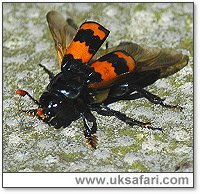
|

|
|
 Sent
to you Sent
to you
by e-mail
|
|
Simply
enter your details and hit the send button
more
info |
|


Click Here

Links
Advertise
Terms of Use
Contributors
About Us
Contact Us
|
 |
Go back
 | Bookmark
| Bookmark
 | Print Page
| Print Page  | E-Mail Us
| E-Mail Us 
 

Photo: Perry Lambert
|
|
UK
Safari Tip:
A great way to see all the details on these beetles and other small
creatures is with a special magnifier box - click
here
|
|
Latin name: Nicrophorus vespillo
Size: Approximately 3cms long
Distribution: Found throughout the U.K.
Months seen: April to October
Food: Well known for feeding on the corpses of dead animals. Will also
feed on other insects.
Habitat: Anywhere that dead animals might be found. They often fly
towards lights at night.
Special features: Wing casings are brightly marked with two wavy orange
bands, and also the antennae have bright orange bobbles on the ends.
There are several similar species, all commonly known as Sexton beetles or
burying beetles.
 They get their name from the practice of digging a hole beneath
a dead animal and then pulling the body down into the hole. This photo (click
left) shows a blackbird buried by sexton beetles, with just a few feathers
showing above the ground. They get their name from the practice of digging a hole beneath
a dead animal and then pulling the body down into the hole. This photo (click
left) shows a blackbird buried by sexton beetles, with just a few feathers
showing above the ground.
Sexton beetles usually work in
pairs, and afterwards the female will lay her eggs next to the corpse for her
young to feed on when they hatch.
Did You Know?
It is thought that Sexton beetles can smell a rotting corpse from up to a mile
away.

UK Safari Beetle Section
UK Safari Creepy-Crawlies Section
|
 |

|